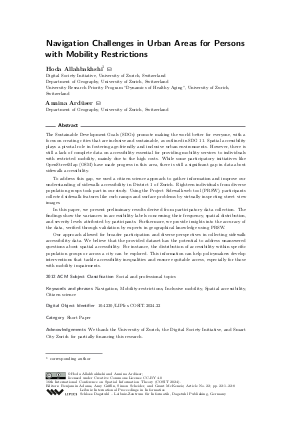Navigation Challenges in Urban Areas for Persons with Mobility Restrictions (Short Paper)
Authors Hoda Allahbakhshi, Annina Ardüser
-
Part of:
Volume:
16th International Conference on Spatial Information Theory (COSIT 2024)
Part of: Series: Leibniz International Proceedings in Informatics (LIPIcs)
Part of: Conference: Conference on Spatial Information Theory (COSIT) - License:
 Creative Commons Attribution 4.0 International license
Creative Commons Attribution 4.0 International license
- Publication Date: 2024-09-09
File

PDF
LIPIcs.COSIT.2024.22.pdf
- Filesize: 1.49 MB
- 8 pages
Document Identifiers
Subject Classification
ACM Subject Classification
- Social and professional topics
Keywords
- Navigation
- Mobility-restrictions
- Inclusive mobility
- Spatial accessibility
- Citizen science
Metrics
- Access Statistics
-
Total Accesses (updated on a weekly basis)
0PDF Downloads0Metadata Views
Abstract
The Sustainable Development Goals (SDGs) promote making the world better for everyone, with a focus on creating cities that are inclusive and sustainable, as outlined in SDG 11. Spatial accessibility plays a pivotal role in fostering age-friendly and inclusive urban environments. However, there is still a lack of complete data on accessibility essential for providing mobility services to individuals with restricted mobility, mainly due to the high costs. While some participatory initiatives like OpenStreetMap (OSM) have made progress in this area, there is still a significant gap in data about sidewalk accessibility. To address this gap, we used a citizen science approach to gather information and improve our understanding of sidewalk accessibility in District 1 of Zurich. Eighteen individuals from diverse population groups took part in our study. Using the Project Sidewalk web tool (PRSW), participants collected sidewalk features like curb ramps and surface problems by virtually inspecting street view images. In this paper, we present preliminary results derived from participatory data collection. The findings show the variances in accessibility labels concerning their frequency, spatial distribution, and severity levels attributed by participants. Furthermore, we provide insights into the accuracy of the data, verified through validation by experts in geographical knowledge using PRSW. Our approach allowed for broader participation and diverse perspectives in collecting sidewalk accessibility data. We believe that the provided dataset has the potential to address unanswered questions about spatial accessibility. For instance, the distribution of accessibility within specific population groups or across a city can be explored. This information can help policymakers develop interventions that tackle accessibility inequalities and ensure equitable access, especially for those with mobility impairments.
Cite As Get BibTex
Hoda Allahbakhshi and Annina Ardüser. Navigation Challenges in Urban Areas for Persons with Mobility Restrictions (Short Paper). In 16th International Conference on Spatial Information Theory (COSIT 2024). Leibniz International Proceedings in Informatics (LIPIcs), Volume 315, pp. 22:1-22:8, Schloss Dagstuhl – Leibniz-Zentrum für Informatik (2024)
https://doi.org/10.4230/LIPIcs.COSIT.2024.22
BibTex
@InProceedings{allahbakhshi_et_al:LIPIcs.COSIT.2024.22,
author = {Allahbakhshi, Hoda and Ard\"{u}ser, Annina},
title = {{Navigation Challenges in Urban Areas for Persons with Mobility Restrictions}},
booktitle = {16th International Conference on Spatial Information Theory (COSIT 2024)},
pages = {22:1--22:8},
series = {Leibniz International Proceedings in Informatics (LIPIcs)},
ISBN = {978-3-95977-330-0},
ISSN = {1868-8969},
year = {2024},
volume = {315},
editor = {Adams, Benjamin and Griffin, Amy L. and Scheider, Simon and McKenzie, Grant},
publisher = {Schloss Dagstuhl -- Leibniz-Zentrum f{\"u}r Informatik},
address = {Dagstuhl, Germany},
URL = {https://drops.dagstuhl.de/entities/document/10.4230/LIPIcs.COSIT.2024.22},
URN = {urn:nbn:de:0030-drops-208378},
doi = {10.4230/LIPIcs.COSIT.2024.22},
annote = {Keywords: Navigation, Mobility-restrictions, Inclusive mobility, Spatial accessibility, Citizen science}
}
Author Details
- Digital Society Initiative, University of Zurich, Switzerland
- Department of Geography, University of Zurich, Switzerland
- University Research Priority Program "Dynamics of Healthy Aging", University of Zurich, Switzerland
Acknowledgements
We thank the University of Zurich, the Digital Society Initiative, and Smart City Zurich for partially financing this research.
References
- Hoda Allahbakhshi. Towards an Inclusive Urban Environment: A Participatory Approach for Collecting Spatial Accessibility Data in Zurich. In proceeding of the 12th International Conference on Geographic Information Science (GIScience 2023), volume 277 of Leibniz International Proceedings in Informatics (LIPIcs), pages 13:1-13:6. Schloss Dagstuhl - Leibniz-Zentrum für Informatik, 2023. URL: https://doi.org/10.4230/LIPIcs.GIScience.2023.13.
- Javier Borge-Holthoefer Daniel Rhoads, Albert Solé-Ribalta. The inclusive 15-minute city: Walkability analysis with sidewalk networks. Computers, Environment, and Urban Systems, 100:101936, 2023. URL: https://doi.org/10.1016/j.compenvurbsys.2022.101936.
-
Tatiana Eliseeva, Olivia Höhener, David Michael Kretzer, Regina Lenart-Gansiniec, Anke Maatz, Mike Martin, Ursina Roffler, Susanne Tönsmann, Evgenia Tsianou, and Stefan Wiederkehr. Practicing Citizen Science in Zurich: Handbook. Zurich: Citizen Science Center Zurich, 2021.

- Jon E Froehlich, Anke M Brock, Anat Caspi, João Guerreiro, Kotaro Hara, Reuben Kirkham, Johannes Schöning, and Benjamin Tannert. Grand challenges in accessible maps. Interactions, 26(2):78-81, 2019. URL: https://doi.org/10.1145/3301657.
- O. Golubchikov. People-smart sustainable cities. Available at SSRN 3757563, 2020. URL: https://ssrn.com/abstract=3757563.
- Hassan A Karimi, Lei Zhang, and Jessica G. Benner. Personalized accessibility map (pam): A novel assisted wayfinding approach for people with disabilities. Annals of GIS, 20(2):99-108, 2014. URL: https://doi.org/10.1080/19475683.2014.904438.
-
Saha Manaswi et al. Project sidewalk: A web-based crowdsourcing tool for collecting sidewalk accessibility data at scale. In Proceedings of the 2019 CHI Conference on Human Factors in Computing Systems, pages 1-14, 2019.

-
MA Mostafavi. Mobilisig: Development of a geospatial assistive technology for navigation of people with motor disabilities. In présenté à Spatial Knowledge and Information Conference, Alberta, Canada. 2015, 2015.

- P. Neis and D. Zielstra. Generation of a tailored routing network for disabled people based on collaboratively collected geodata. Applied Geography, 47:70-77, 2014. https://doi.org/10.1016/j.apgeog.2013.12.004.
-
World Health Organization. Decade of healthy ageing: baseline report. World Health Organization, 2021.

- Daisuke Takagi, Katsunori Kondo, and Ichiro Kawachi. Social participation and mental health: moderating effects of gender, social role, and rurality. BMC public health, 13:1-8, 2013. URL: https://doi.org/10.1186/1471-2458-13-701.
-
Stanislaw Weglarczyk. Kernel density estimation and its application. In ITM Web of Conferences, volume 23, page 00037, 2018.

- Bradley Wheeler, Meirman Syzdykbayev, Hassan A Karimi, Raanan Gurewitsch, and Yanbo Wang. Personalized accessible wayfinding for people with disabilities through standards and open geospatial platforms in smart cities. Open Geospatial Data, Software and Standards, 5(12):1-15, 2020. URL: https://doi.org/10.1186/s40965-020-00075-5.
